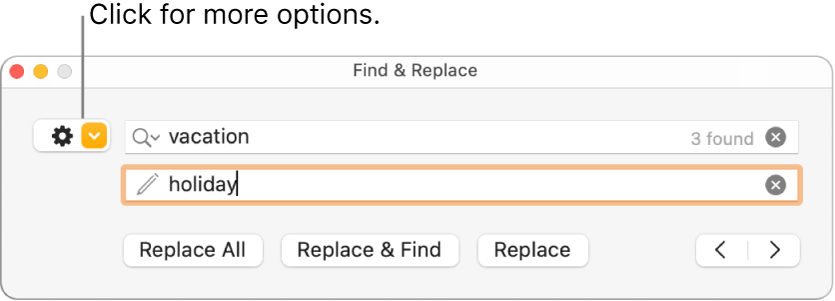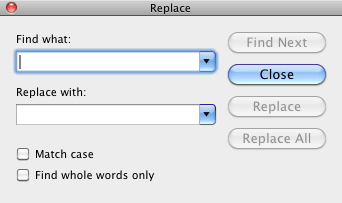

Second, although Excel doesn't support regular expressions, it does support two wildcards, the question mark (?), which matches one character, and the asterisk (*), which matches more than one character. So, if I select a column, I can more quickly find just what I want inside this column.

Here's a couple more quick tips on Find and Replace.īefore you find, if you make a selection first, you automatically limit the search to that selection. On windows, after you run Find all, you can use the arrow keys to step through results. Excel will open up the Replace dialog with the replace field visible and in focus.
#Find and replace on mac windows#
To do a find and replace, use Control + H on both Windows and Mac. Type in the Find What text box (there are spaces before and after the hyphen). Click Home > Find & Select > Replace to open the Find and Replace dialog box. To reverse direction, use Control + Shift + F4 on Windows, Command + Shift + G on a Mac. We want to replace all occurrences of the ID with nothing to remove them. This is a handy way to step through matches without the find dialog blocking your view. You can repeat the last search with the keyboard shortcut Shift F4 on Windows, and Command G on a Mac. If you hold down the shift key, you can move through matches in the opposite direction.Īfter you run a find, and the Find dialog is closed. Once you've found something, you can press Return or Enter to "find again". To find something in Excel, you can use Control + F on Windows and Command + F on a Mac. This can be very useful for swapping values and similar operations.In this video, we'll look at the shortcuts you can use for find and replace in Excel. With regular expressions enabled, the replace value supports capture group expressions in the format $n where n is the match index. In the Replace With box, type the replacement. To replace found text: Select the magnifying glass, and then select Replace. If you have advanced search needs and are not familiar with regular expressions, there are some great resources around the web.įor those familiar, know that Drafts implementation is based on NSRegularExpression and any documentation on its syntax is applicable. In the upper-right corner of the document, in the search box, type the word or phrase that you want to find, and Word will highlight all instances of the word or phrase throughout the document. Including toggling whether the search is case-sensitive, and more importantly, the ability to enable regular expressions.

In addition to basic finds, the find and replace feature has a couple of additional options, which can be viewed by tapping the “Show options” button. The Replace all button at the top will replace every occurrence in the results. Use the Redact tab to mark a single word.
#Find and replace on mac update#
This will also update the results of the find. Use the Replace tab to substitute words from the displayed search queries with replacement text, and click Replace.



 0 kommentar(er)
0 kommentar(er)
